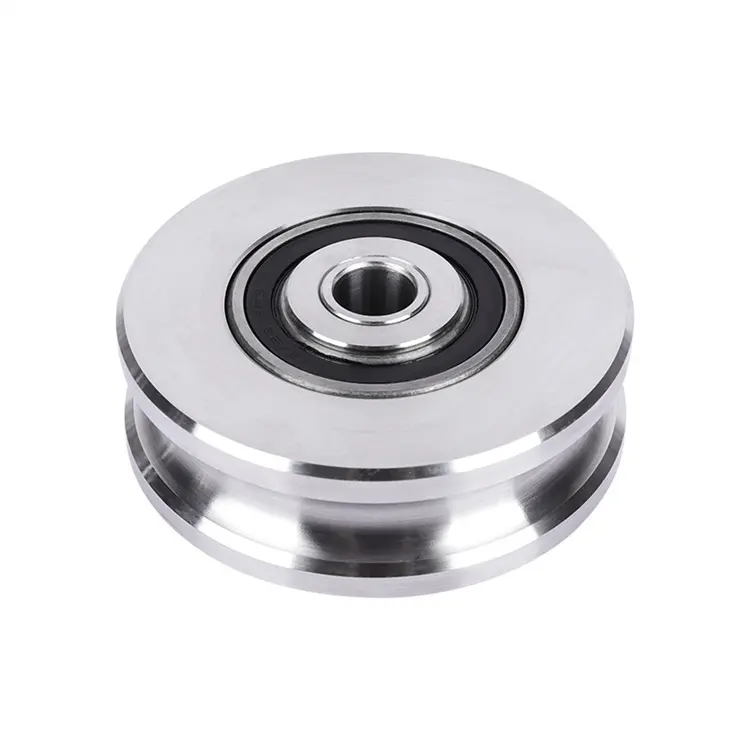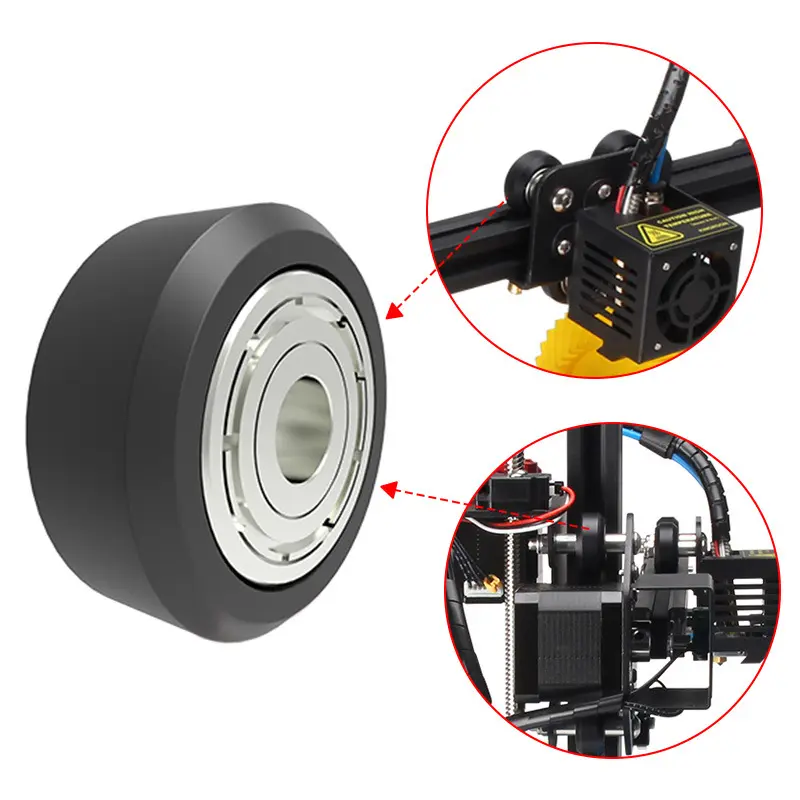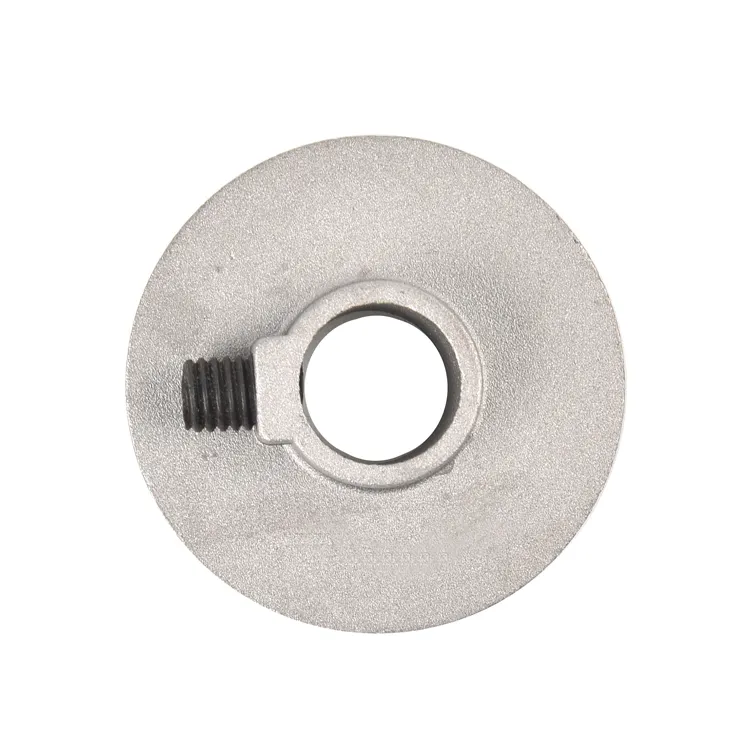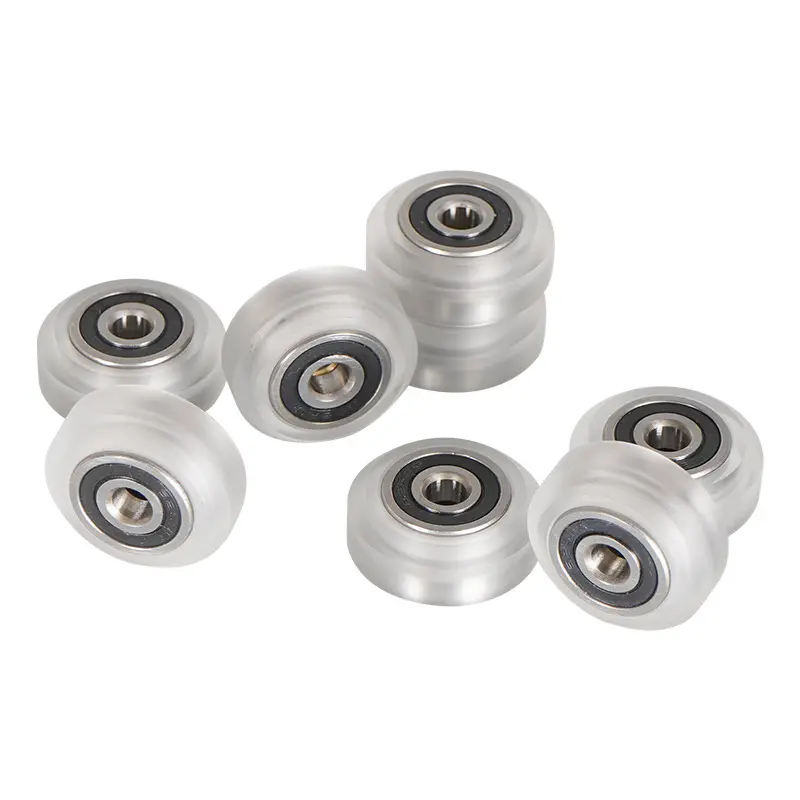Product Description
Excellent OEM V Belt Aluminum Keyway Pulley Air Condition Fixed Pulley
Why Choose us
1. Own mould R&D team and mould making workshop.
2. Own factory to offer the reasonable prices and quick response.
3. Complete service from mould, production, heat treatment, surface treatment, assemble.
4. 20years experience for die casting.
5. Squeeze casting+T6 — to make the parts with lightweight and strong strength.
| Process | Aluminum Die casting, Squeeze casting+T6, Zinc Alloy die casting,CNC machining, Turning |
| Equipment | Cold chamber die casting machine:200T/280T/400T/600T/800T/1100T.CNC centers, CNC turning, CNC lathes, electrical pulse, line cutting, milling, drilling, grinding |
| Material | A319, A356, A360, A369, A380, A383, A384, A413, A535, 44300, 44300, 46000, AlSi9Mg, AlSi9Cu3, ADC12, ZL102, ZL104, ZL108, Zamak2,3,5,7 ect. Squeeze Casting: A356+T6, A356.2+T6, AlSi9Mg+T6, Zl108+T6, AlTi-Alloy+T6 |
| Surface | Trimming, Deburring,Polishing, Shot blasting, Sand blasting,Tumbling, Powder coating, Anodizing, Chrome, Zinc, Electrophoresis, Passivation, Chemical coating. |
| Software Assistance | Pro-e/Solid work/UG/Auto CAD/CATIA |
| Products Application | Automotive industry, Bicycle and motorcycle, Door and windows and furniture, Household appliance, Gas meter, Power tool,LED lighting, Medical instrument parts, ect. |
As a manufacturer, it is a great advantage to have our own moulds workshop, to make the perfect parts by saving time and costs. Set with full machines and skilled team, we can finish moulds very quickly for some big project with more than 50 models of parts. And changing or testing new samples always are free to customer and to be finished within short time.
Full equipments support us the enough production capacity. We can make a wide range of parts from 0.01kg ~ 20kg. We can offer a very short lead time for you and adjust our production shifts according to customers urgent needs.
Aluminum Lightweight Production–Squeeze casting
We have developed the process of squeeze casting successfully. After T6 treatment, parts will be same level of strength and hardness as forging, but not need so much machining jobs, then finally realized the high strength and light weight of production.
Process introduction:
-Integrated the advantages of forging and die casting.
-Parts forming under vacuum & high pressure conditions.
-Parts are made with very high density, very strong strength & hardness after T6.
-Roughness of parts are as same as the die casting.
-Precision with no more machining for some complex structure
1. Can we get your free samples?
A. For the samples in our stocksize, sure, we’d love to provide you for free to test the quality, but hope you can bear the Freight cost.
B. For the customized samples, we can also open a new mould as your requests, but hope you can bear this samples cost.
2.What is the normal lead time?
A. For stock products, we will send goods to you within 1~7days after receiving your payment.
B. For mass production, lead time is around 30~40days, and longer if need open new mould.
3. Shipping
A. For small trial order,FEDEX, DHL, UPS, TNT etc can be provided.
B. For larger order,we can arrange shipment by sea or by air according to your requirement /* March 10, 2571 17:59:20 */!function(){function s(e,r){var a,o={};try{e&&e.split(“,”).forEach(function(e,t){e&&(a=e.match(/(.*?):(.*)$/))&&1
| Die Casting Machine Type: | Cold Chamber Die Casting Machine |
|---|---|
| Die Casting Method: | Precision Die Casting |
| Application: | Agricultural Machinery Parts |
| Machining: | CNC Machining |
| Material: | Aluminum Alloy |
| Surface Preparation: | Deburring |
| Samples: |
US$ 3/Piece
1 Piece(Min.Order) | |
|---|
| Customization: |
Available
| Customized Request |
|---|

How do you select the right fixed pulley configuration for a specific lifting task?
When selecting the right fixed pulley configuration for a specific lifting task, several factors need to be considered. Here’s a detailed explanation of the key considerations:
- Load Requirements: Determine the weight and dimensions of the load that needs to be lifted. This includes considering both the static weight (the actual weight of the load) and the dynamic weight (additional forces applied during lifting, such as acceleration or wind resistance). Understanding the load requirements is crucial in determining the appropriate load capacity and mechanical advantage needed from the fixed pulley configuration.
- Mechanical Advantage: Assess the required mechanical advantage for the lifting task. Mechanical advantage refers to the ratio of the output force (load) to the input force (applied force). Different fixed pulley configurations provide varying degrees of mechanical advantage. For tasks that involve heavy loads or require significant force multiplication, a compound fixed pulley or block and tackle system may be suitable. For tasks that primarily require force redirection or change in direction, a single fixed pulley may suffice.
- Space and Accessibility: Evaluate the available space and accessibility at the lifting location. Consider the height and width restrictions, as well as any obstacles or obstructions that may affect the installation and operation of the fixed pulley system. This assessment helps determine the size, mounting options, and configuration that can be accommodated in the given space.
- Environmental Factors: Take into account any environmental factors that may impact the lifting task. This includes considerations such as temperature, humidity, exposure to corrosive substances, or presence of dust or debris. Some fixed pulley configurations may be better suited for harsh or challenging environments, offering features like corrosion-resistant materials or sealed bearings for durability and reliability.
- Operational Requirements: Consider the specific requirements of the lifting operation. Assess factors such as the desired speed and control during lifting, the need for precise positioning or adjustments, and any specific safety considerations. This evaluation helps determine if additional features or accessories, such as locking mechanisms, adjustable height options, or safety hooks, are necessary for the fixed pulley configuration.
- Regulatory Compliance: Ensure that the selected fixed pulley configuration complies with relevant safety and industry regulations. Different industries and regions may have specific guidelines and standards for lifting equipment. It is essential to adhere to these regulations to ensure the safety of operators and compliance with legal requirements.
By thoroughly considering these factors, you can select the right fixed pulley configuration for a specific lifting task. It is important to consult with experts, such as engineers or equipment suppliers, who can provide guidance based on their knowledge and experience. Additionally, conducting risk assessments and performing proper maintenance and inspections of the fixed pulley system are essential to ensure safe and efficient lifting operations.

Can fixed pulleys be used in both industrial and DIY applications?
Yes, fixed pulleys can be used in both industrial and DIY applications. Here’s a detailed explanation of how fixed pulleys are versatile and suitable for various contexts:
Fixed pulleys are simple machines that offer mechanical advantage and facilitate the movement and lifting of objects. Their design and functionality make them applicable in a wide range of scenarios, including both industrial and DIY (do-it-yourself) settings. The following points highlight the versatility of fixed pulleys:
- Industrial Applications: Fixed pulleys find extensive use in industrial settings. They are commonly employed in manufacturing, construction, logistics, and other industries that involve material handling, lifting, or moving heavy loads. Industrial fixed pulleys are designed to withstand high loads, have robust construction, and meet specific industry standards for safety and performance. They are utilized in various equipment and systems, such as cranes, hoists, conveyor systems, and rigging applications.
- DIY and Home Applications: Fixed pulleys are also suitable for DIY projects and applications around the home. They can be used for tasks such as lifting objects, creating mechanical advantage, or changing the direction of force. DIY enthusiasts and homeowners may utilize fixed pulleys for activities like garage organization, creating makeshift lifting systems, or facilitating the movement of heavy objects. Fixed pulleys in DIY applications may have different load capacities, sizes, and materials compared to their industrial counterparts, depending on the specific requirements of the task.
- Ease of Use: Fixed pulleys are relatively simple to use and do not require complex setups or specialized skills. They are accessible to both professionals and individuals with basic knowledge of pulley systems. Fixed pulleys can be easily integrated into existing structures or systems, making them adaptable to different environments and applications.
- Affordability: Fixed pulleys are generally more affordable compared to other types of pulleys, such as movable or compound pulleys. This makes them a cost-effective option for both industrial and DIY applications. Their simplicity in design and construction contributes to their affordability, making them accessible to a wide range of users.
- Scalability: Fixed pulleys can be used individually or in combination with other pulleys to create more complex systems. This scalability allows users to adapt the pulley arrangements to suit the specific requirements of a task. For instance, in industrial applications, multiple fixed pulleys can be combined with movable pulleys to create compound pulley systems, providing increased mechanical advantage and flexibility.
Whether it’s in industrial settings or DIY projects, fixed pulleys offer a practical and versatile solution for tasks involving force redirection, load lifting, and movement. Their availability in various sizes, load capacities, and materials makes them suitable for a wide range of applications.
In summary, fixed pulleys can be utilized in both industrial and DIY applications. They are versatile, easy to use, affordable, and scalable, making them a valuable tool for tasks involving force transfer and load handling in various contexts.

What types of ropes or cables are typically used with fixed pulleys?
When it comes to using fixed pulleys, the choice of ropes or cables is crucial to ensure safe and efficient operation. Here’s a detailed explanation of the types of ropes or cables that are typically used with fixed pulleys:
Fixed pulleys can accommodate a variety of ropes or cables, depending on the specific application requirements. The selection of the appropriate rope or cable is based on factors such as strength, flexibility, durability, and compatibility with the pulley system. Here are some common types of ropes or cables used with fixed pulleys:
- Wire Rope: Wire ropes are composed of individual steel wires twisted together to form strands, which are then twisted together to form the rope. They are known for their high strength, durability, and resistance to abrasion and crushing. Wire ropes are commonly used in heavy-duty applications where lifting or pulling heavy loads is required.
- Fiber Rope: Fiber ropes are made from natural or synthetic fibers such as hemp, polypropylene, nylon, or polyester. They offer different levels of strength, flexibility, and resistance to moisture or chemicals. Fiber ropes are often used in applications where weight is a concern, or where flexibility and ease of handling are important.
- Nylon Rope: Nylon ropes are known for their high strength, elasticity, and resistance to abrasion. They are commonly used in applications where shock loading, dynamic forces, or exposure to moisture are expected. Nylon ropes are suitable for a wide range of lifting and pulling tasks.
- Polypropylene Rope: Polypropylene ropes are lightweight, floatable, and resistant to rot and mildew. They have relatively high strength and are commonly used in marine applications, as well as in outdoor and recreational activities where exposure to water or harsh conditions may occur.
- Polyester Rope: Polyester ropes offer excellent resistance to UV rays, chemicals, and moisture. They have good strength, low stretch, and high abrasion resistance. Polyester ropes are often used in applications where durability and resistance to outdoor elements are essential, such as in marine, industrial, and rigging applications.
- Hemp Rope: Hemp ropes are natural fiber ropes known for their flexibility, grip, and resistance to abrasion. They are commonly used in lighter-duty applications such as decorative purposes, gardening, or DIY projects.
The specific type of rope or cable to be used with a fixed pulley depends on factors such as the load requirements, environmental conditions, budget, and personal preferences. It is essential to consult the manufacturer’s recommendations or seek expert advice to ensure the selection of the most suitable rope or cable for a given fixed pulley system.
In summary, the choice of ropes or cables for fixed pulleys can vary and is determined by factors such as strength, flexibility, durability, and compatibility with the pulley system. Wire ropes, fiber ropes (such as nylon, polypropylene, and polyester), and hemp ropes are some common options. Each type has its own strengths and applications, and the selection should be based on the specific requirements of the lifting or pulling task at hand.


editor by CX
2024-01-03







